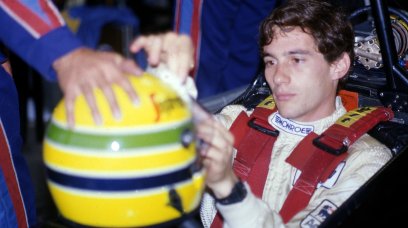These days, big anniversaries are only usually marked in multiples of 5 or years that end in 0 since the event passed.
Take the deaths of Roland Ratzenberger and Ayrton Senna in 1994. It was in 2019 - 25 years on - that special reflective packages were produced and sizeable tributes paid whilst in the intervening years, a quiet respect was paid.
Of course with it being 30 years since the Austrian rookie and Brazilian three-time world champion were killed, there would be a lot of focus around their deaths at Imola, especially with the Emilia Romagna Grand Prix taking place just 18 days after three decades turned into four.
A Senna special helmet like Pierre Gasly wore at Imola and TV packages being made up of a current driver - in this case also Gasly - driving an iconic Senna car are to be expected as was a demo of the 1993 McLaren MP4-8 by Sebastian Vettel on race-day morning.
But how much is enough, when do we reach a saturation with the legend and myth of Ayrton Senna instead of remembering the flawed genius that he was?
Viewed by others:
The Senna myth
Much of the myth and deification of Senna stems from the 2010 movie Senna which presented its subject in a hagiographic way.
Released 16 years after the death of Senna, the film painted Alain Prost out to be the villain and disruptor to the serene, god-like Senna. Prost was "upset" with how the film depicted his relationship with Senna, but in introducing Senna's story to a new generation of fans, first impressions stick.
What also did not help in the rise of the Senna cult was a segment broadcast on Top Gear where Jeremy Clarkson interviewed Lewis Hamilton, who drove Senna's iconic MP4-4. Clips of Senna racing were interwoven with a further interview with Martin Brundle - Senna's old F3 rival - where again, the Sao Paulo karter was depicted as a god-like figure who gave away huge sums of money to charity to help fight poverty.
To be fair to Top Gear, the most reckless and dangerous act in the history of Formula 1 where Senna took Prost out at Turn 1 of the 1990 Japanese Grand Prix to essentially settle a score and prove a point from 1989 and that pole position was on the 'wrong' side of the track, respectively, was shown in a fairer light than the film.
In the film, this is portrayed as Senna suffering some massive injustice and that he firmly righted a wrong.
The Kennedy comparison
Now of course, anytime a global icon is cut down in their prime, as Senna was in front of a global audience of millions, the myth around them will, in time, start to overtake their legacy.
One other notable example is President John F Kennedy who was assassinated in Dallas, Texas on November 22nd, 1963.
Just a week after her husband's assassination, widow Jackie Kennedy moved to immediately protect her slain husband's legacy with her memorable 'Camelot' interview to Life magazine at the Kennedy Hyannis Port compound.
It worked.
Today, Kennedy is remembered as a fallen symbol of the 1960s, the man whose dream it was to send man to the Moon and return him safely to the Earth by the end of the decade, the man on whose death Civil Rights voting legislation was piggybacked by successor Lyndon B Johnson to ram through a divided Congress.
The World War II veteran who was going to usher America and the free world into a new period of freedom - the man whose legacy can probably be summed up with one of the most iconic lines any American president has ever delivered: 'Ask not what your country can do for you, ask what you can do for your country."
But Kennedy's life and presidency was far rockier. Here was a man who tried to invade Cuba early in his term, the Bay of Pigs fiasco, tried to assassinate Cuban leader Fidel Castro and who had multiple affairs whilst president.
Also hidden from public view, as it did not fit the PR model of a sprightly, modern, youthful, energetic president was his debilitating health conditions, for which he took medication daily. Indeed, in a cruel twist of fate, Kennedy was wearing a back brace to keep him up-right that afternoon in Dallas, which prevented him from moving out of the scope of Lee Harvey Oswald's rifle.
Even now, some 61 years on from Kennedy's assassination, he is still ranked as one of the greatest presidents, despite only serving 1,036 days - the seventh shortest presidency of the 46 to date.
But what has this got to do with Senna?
In the run-up to May 1st and in the aftermath, there has been a glut of content posted on the official F1 social media channels, decked out in the yellow, blue and green that Senna carried on his helmet.
Even now, he is perhaps the McLaren driver, so it is no surprise that the team has opted for a special livery in those colours for Monaco.
But to fully evaluate Ayrton Senna - we must also take into account the bad side.
It is all good and well wondering what Senna might have done had he not been killed in terms of future world championship wins and a run at the Brazilian presidency, but he did not achieve those.
Being killed whilst doing his job should not count towards a boost in the Senna legacy, but it unfortunately has.
It feels as if Ayrton Senna the myth is being worshipped rather than Ayrton Senna himself - and that is doing a massive disservice to Senna.
Subscribe to our YouTube channel and win an F1 scale model car of your favourite driver!
Win amazing F1 prizes!Most read
In this article


























Join the conversation!